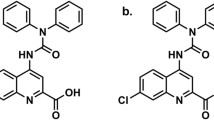Abstract
Several dyes, representing different structural classes, inhibit [3H]flunitrazepam binding to brain specific receptors in the rat with 50% inhibition in the 1 to 100 μM range. Crystal Violet and Methyl Violet 2B inhibited more potently in the forebrain than in the cerebellum. Congo Red yielded a Hill number near 2.3, probably reflecting positive cooperativity between interacting binding sites in benzodiazepine receptor complexes. Toluidine Blue 0 was the most potent of the dyes tested (IC50=1 μM in cerebellum) and inhibited more potently in cerebellum than in forebrain.
Similar content being viewed by others
References
Feingold, B., German, D. F., Braham, R. M., andSimmers, E. 1973. Read before the annual convention of the American Medical Association, New York.
Harley, J. P., Ray, R. S., Tomasi, L., Eichman, P. L., Matthews, C. G., Chun, R., Cleeland, C. S., andTraisman, E. 1978. Hyperkinesis and food additives: Testing the Feingold Hypothesis. Pediatrics, 61:818–828.
Logan, W. J., andSwanson, J. M., 1979. Erythrosin B inhibition of neurotransmitter acculation by rat brain homogenate. Science, 206:363–364.
Lafferman, J. A., andSilbergeld, E. K. 1979. Erythrosin B inhibits dopamine transport in rat caudate synaptosomes. Science, 205:410–412.
Silbergeld, E. K., 1981. Erythrosin B is a specific inhibitor of high affinity,3H-ouabain binding and ion transport in rat brain. Neuropharmacology, 20:87–90.
Squires, R. F., Benson, D. I., Braestrup, C., Coupet, J., Klepner, C. A., Myers, V., andBeer, B. 1979. Some properties of brain specific benzodiazepine receptors: New evidence for multiple receptors. Pharmacol. Biochem. Behav. 10:828–830.
Braestrup, C., Nielsen, M., andOlsen, R. E. 1980. Urinary and brain β-carboline-3-carboxylates as potent inhibitors of brain benzodiazepine receptors. Proc. Natl. Acad. Sci. 77:2288–2292.
Nielsen, M., andBraestrup, C. 1980. Ethyl β-carboline-3-carboxylate shows differential benzodiazepine receptor interaction. Nature 286:606–607.
Nielsen, M., Schou, H. andBraestrup, C. 1981.3H Propyl β-carboline-3-carboxylate binds specifically to brain benzodiazepine receptors. J. Neurochem. 36:276–285.
Squires, R. F. 1981. GABA receptors regulate the affinities of anions required for brain specific benzodiazepine binding. Adv. Biochem. Psychopharm. 26:129–138.
Braestrup, C., andNielsen, M. 1981. GABA reduces binding of3H-methyl β-carboline-3-carboxylate to brain benzodiazepine receptors. Nature 294:472–474.
Hunkeler, W., Mohler, H., Pieri, L., Polc, P. Bonetti, E. P., Cumin, R. Schaffner, R., andHaefely, W. 1981. Selective antagonists of benzodiazepines. Nature 290:514–516.
Mohler, H., Burkard, W. P., Keller, H. H., Richards, J. G., andHaefely, W. 1981. Benzodiazepine antagonist Ro 15-1788. Binding characteristics and interaction with drug-induced changes in dopamine turnover and cerebellar cGMP levels. J. Neurochem. 37:714–722.
Mohler, H., andRichards, J. G. 1981. Agonist and antagonist benzodiazepine receptor interaction in vitro. Nature 294:763–765.
Blanchard, J. C., Boireau, A., Garret, C., andJulou, L. 1979. In vitro and in vivo inhibition by zopiclone of benzodiazepine binding to rodent brain receptors. Life Sci. 24:2417–2420.
Czernik, A. J., Petrack, B., Kalinsky, H. J., Psychoyos, S., Cash, W. D., Tsai, C., Rinehart, R. K., Granat, F. R., Lovell, R. A., Brundish, D. E., andWade, R. 1982. CGS 8216: receptor binding characteristics of a potent benzodiazepine antagonist. Life Sci. 30:363–372.
Antoniadis, A., Muller, W. E., andWollert, U. 1980. Central nervous system stimulating and depressing drugs as possible ligands of the benzodiazepine receptor. Neuropharmacology 19:121–124.
Braestrup, C., Schmiechen, R., Neef, G., Nielsen, M., andPeterson, E. N. 1982. Interaction of convulsive ligands with benzodiazepine receptors. Science 216:1241–1243.
Tenen, S. S., andHirsch, J. D. 1980. β-carboline-3-carboxylic acid ethyl ester antagonizes diazepam activity. Nature 288:609–610.
Oakley, N. R. andJones, B. J. 1980. The proconvulsant and diazepam-reversing effects of ethyl-β-carboline-3-carboxylate. Eur. J. Pharmacol. 68:381–382.
Cowen, P. J., Green, A. R., Nutt, D. J., andMartin, I. L. 1981 Ethyl β-carboline carboxylate lowers seizure threshold and antagonizes flurazepam-induced sedation in rats. Nature, 290:54–55.
Geller, H. 1982. Personal Communication.
Klepner, C. A., Lippa, A. S., Benson, D. I., Sano, M. C., andBeer, B. 1979 Resolution of two biochemically and pharmacologically distinct benzodiazepine receptors. Pharmacol. Biochem. Behav. 11:457–462.
Young, W. S., Niehoff, D., Kuhar, M. J., Beer, B., andLippa, A. S. 1981. Multiple benzodiazepine receptor localization by light microscopic radiohistochemistry. J. Pharmacol. Exp. Therap. 216:425–430.
Squires, R. F. 1981. Certain GABA mimetics reduce the affinity of anions required for benzodiazepine binding in a GABA-reversible way. Drug Develop. Res. 1:211–221.
Yousufi, M. A., Thomas, J. W., andTallman, J. F. 1979. Solubilization of benzodiazepine binding site from rat cortex. Life Sci. 25:563–570.
Martini, C., Lucacchini, A., Ronca, G., Hrelia, S., andRoss, C. A. 1982. Isolation of putative benzodiazepine receptors from rat brain membranes by affinity chromatography. J. Neurochem. 38:15–19.
Asano, T., andOgasawara, N. 1981. Solubles gamma-aminobutyric acid and benzodiazepine receptors from rat cerebral cortex. Life Sci. 29:193–200.
Mohler, H., Battersby, M. K., andRichards, J. G. 1980. Benzodiazepine receptor protein identified and visualized in brain tissue by a photoaffinity label. Proc. Natl. Acad. Sci. 77:1666–1670.
Thomas, J. W., andTallman, J. F. 1981. Characterization of photoaffinity labeling of benzodiazepine binding sites. J. Biol. Chem. 26:9839–9842.
Sieghart, W., andKarobath, M. 1980. Molecular heterogeneity of benzodiazepine receptors. Nature 286:285–287.
Doble, A., andIversen, L. L. 1982. Molecular size of benzodiazepine receptor in rat brain in situ: evidence for a functional dimer. Nature 295:522–523.
Author information
Authors and Affiliations
Rights and permissions
About this article
Cite this article
Smith, T.M., Squires, R.F. Differential inhibition of brain specific [3H]flunitrazepam binding by several types of dyes. Neurochem Res 8, 1177–1183 (1983). https://doi.org/10.1007/BF00964931
Accepted:
Issue Date:
DOI: https://doi.org/10.1007/BF00964931




